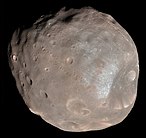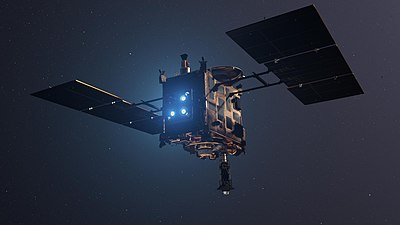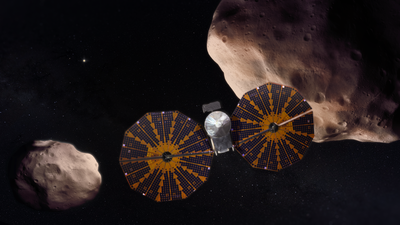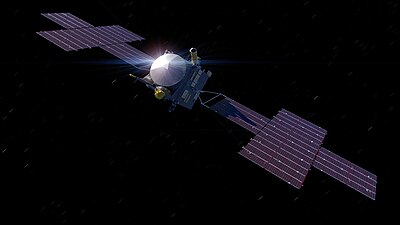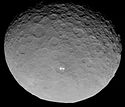Asteroid
An asteroid is a minor planet—an object that is neither a true planet nor a comet—that orbits within the inner Solar System. They are rocky, metallic, or icy bodies with no atmosphere. The size and shape of asteroids vary significantly, ranging from small rubble piles under a kilometer across to Ceres, a dwarf planet almost 1000 km in diameter.
Of the roughly one million known asteroids,
Asteroids have historically been observed from Earth; the
Near-Earth asteroids can threaten all life on the planet; an asteroid impact event may have resulted in the Cretaceous–Paleogene extinction. Different asteroid deflection strategies have been proposed; the Double Asteroid Redirection Test spacecraft, or DART, was launched in 2021 and intentionally impacted Dimorphos in September 2022, successfully altering its orbit by crashing into it.
History of observations
Despite their large numbers, asteroids are a relatively recent discovery, with the first known asteroid—Ceres—only being identified in 1801.[3] Only one asteroid, 4 Vesta, which has a relatively reflective surface, is normally visible to the naked eye. When favorably positioned, 4 Vesta can be seen in dark skies. Rarely, small asteroids passing close to Earth may be visible to the naked eye for a short amount of time.[4] As of April 2022[update], the Minor Planet Center had data on 1,199,224 minor planets in the inner and outer Solar System, of which about 614,690 had enough information to be given numbered designations.[5]
Discovery of Ceres
In 1772, German astronomer Johann Elert Bode, citing Johann Daniel Titius, published a numerical procession known as the Titius–Bode law (now discredited). Except for an unexplained gap between Mars and Jupiter, Bode's formula seemed to predict the orbits of the known planets.[6][7] He wrote the following explanation for the existence of a "missing planet":
This latter point seems in particular to follow from the astonishing relation which the known six planets observe in their distances from the Sun. Let the distance from the Sun to Saturn be taken as 100, then Mercury is separated by 4 such parts from the Sun. Venus is 4 + 3 = 7. The Earth 4 + 6 = 10. Mars 4 + 12 = 16. Now comes a gap in this so orderly progression. After Mars there follows a space of 4 + 24 = 28 parts, in which no planet has yet been seen. Can one believe that the Founder of the universe had left this space empty? Certainly not. From here we come to the distance of Jupiter by 4 + 48 = 52 parts, and finally to that of Saturn by 4 + 96 = 100 parts.[8]
Bode's formula predicted another planet would be found with an orbital radius near 2.8 astronomical units (AU), or 420 million km, from the Sun.[7] The Titius–Bode law got a boost with William Herschel's discovery of Uranus near the predicted distance for a planet beyond Saturn.[6] In 1800, a group headed by Franz Xaver von Zach, editor of the German astronomical journal Monatliche Correspondenz (Monthly Correspondence), sent requests to 24 experienced astronomers (whom he dubbed the "celestial police"),[7] asking that they combine their efforts and begin a methodical search for the expected planet.[7] Although they did not discover Ceres, they later found the asteroids 2 Pallas, 3 Juno and 4 Vesta.[7]
One of the astronomers selected for the search was
The light was a little faint, and of the colour of Jupiter, but similar to many others which generally are reckoned of the eighth magnitude. Therefore I had no doubt of its being any other than a fixed star. [...] The evening of the third, my suspicion was converted into certainty, being assured it was not a fixed star. Nevertheless before I made it known, I waited till the evening of the fourth, when I had the satisfaction to see it had moved at the same rate as on the preceding days.[6]
Piazzi observed Ceres a total of 24 times, the final time on 11 February 1801, when illness interrupted his work. He announced his discovery on 24 January 1801 in letters to only two fellow astronomers, his compatriot Barnaba Oriani of Milan and Bode in Berlin.[3] He reported it as a comet but "since its movement is so slow and rather uniform, it has occurred to me several times that it might be something better than a comet".[6] In April, Piazzi sent his complete observations to Oriani, Bode, and French astronomer Jérôme Lalande. The information was published in the September 1801 issue of the Monatliche Correspondenz.[10]
By this time, the apparent position of Ceres had changed (mostly due to Earth's motion around the Sun), and was too close to the Sun's glare for other astronomers to confirm Piazzi's observations. Toward the end of the year, Ceres should have been visible again, but after such a long time it was difficult to predict its exact position. To recover Ceres, mathematician
Further search
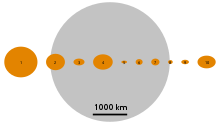
Three other asteroids (
In 1891,
19th and 20th centuries

In the past, asteroids were discovered by a four-step process. First, a region of the sky was photographed by a wide-field telescope or astrograph. Pairs of photographs were taken, typically one hour apart. Multiple pairs could be taken over a series of days. Second, the two films or plates of the same region were viewed under a stereoscope. A body in orbit around the Sun would move slightly between the pair of films. Under the stereoscope, the image of the body would seem to float slightly above the background of stars. Third, once a moving body was identified, its location would be measured precisely using a digitizing microscope. The location would be measured relative to known star locations.[17]
These first three steps do not constitute asteroid discovery: the observer has only found an apparition, which gets a provisional designation, made up of the year of discovery, a letter representing the half-month of discovery, and finally a letter and a number indicating the discovery's sequential number (example: 1998 FJ74). The last step is sending the locations and time of observations to the Minor Planet Center, where computer programs determine whether an apparition ties together earlier apparitions into a single orbit. If so, the object receives a catalogue number and the observer of the first apparition with a calculated orbit is declared the discoverer, and granted the honor of naming the object subject to the approval of the International Astronomical Union.[18]
Naming

By 1851, the Royal Astronomical Society decided that asteroids were being discovered at such a rapid rate that a different system was needed to categorize or name asteroids. In 1852, when de Gasparis discovered the twentieth asteroid, Benjamin Valz gave it a name and a number designating its rank among asteroid discoveries, 20 Massalia. Sometimes asteroids were discovered and not seen again. So, starting in 1892, new asteroids were listed by the year and a capital letter indicating the order in which the asteroid's orbit was calculated and registered within that specific year. For example, the first two asteroids discovered in 1892 were labeled 1892A and 1892B. However, there were not enough letters in the alphabet for all of the asteroids discovered in 1893, so 1893Z was followed by 1893AA. A number of variations of these methods were tried, including designations that included year plus a Greek letter in 1914. A simple chronological numbering system was established in 1925.[12][19]
Currently all newly discovered asteroids receive a provisional designation (such as 2002 AT4) consisting of the year of discovery and an alphanumeric code indicating the half-month of discovery and the sequence within that half-month. Once an asteroid's orbit has been confirmed, it is given a number, and later may also be given a name (e.g. 433 Eros). The formal naming convention uses parentheses around the number—e.g. (433) Eros—but dropping the parentheses is quite common. Informally, it is also common to drop the number altogether, or to drop it after the first mention when a name is repeated in running text.[20] In addition, names can be proposed by the asteroid's discoverer, within guidelines established by the International Astronomical Union.[21]
Symbols
The first asteroids to be discovered were assigned iconic symbols like the ones traditionally used to designate the planets. By 1855 there were two dozen asteroid symbols, which often occurred in multiple variants.[22]
In 1851, after the fifteenth asteroid, Eunomia, had been discovered, Johann Franz Encke made a major change in the upcoming 1854 edition of the Berliner Astronomisches Jahrbuch (BAJ, Berlin Astronomical Yearbook). He introduced a disk (circle), a traditional symbol for a star, as the generic symbol for an asteroid. The circle was then numbered in order of discovery to indicate a specific asteroid. The numbered-circle convention was quickly adopted by astronomers, and the next asteroid to be discovered (16 Psyche, in 1852) was the first to be designated in that way at the time of its discovery. However, Psyche was given an iconic symbol as well, as were a few other asteroids discovered over the next few years. 20 Massalia was the first asteroid that was not assigned an iconic symbol, and no iconic symbols were created after the 1855 discovery of 37 Fides.[a][23]
Terminology
The first discovered asteroid, Ceres, was originally considered a new planet.[b] It was followed by the discovery of other similar bodies, which with the equipment of the time appeared to be points of light like stars, showing little or no planetary disc, though readily distinguishable from stars due to their apparent motions. This prompted the astronomer Sir William Herschel to propose the term asteroid,[c] coined in Greek as ἀστεροειδής, or asteroeidēs, meaning 'star-like, star-shaped', and derived from the Ancient Greek ἀστήρ astēr 'star, planet'. In the early second half of the 19th century, the terms asteroid and planet (not always qualified as "minor") were still used interchangeably.[d]
Traditionally, small bodies orbiting the Sun were classified as
When found, asteroids were seen as a class of objects distinct from comets, and there was no unified term for the two until small Solar System body was coined in 2006. The main difference between an asteroid and a comet is that a comet shows a coma due to sublimation of near-surface ices by solar radiation. A few objects have ended up being dual-listed because they were first classified as minor planets but later showed evidence of cometary activity. Conversely, some (perhaps all) comets are eventually depleted of their surface volatile ices and become asteroid-like. A further distinction is that comets typically have more eccentric orbits than most asteroids; "asteroids" with notably eccentric orbits are probably dormant or extinct comets.[31]
For almost two centuries, from the discovery of
The innermost of these are the Kuiper-belt objects, called "objects" partly to avoid the need to classify them as asteroids or comets.[32] They are thought to be predominantly comet-like in composition, though some may be more akin to asteroids.[33] Furthermore, most do not have the highly eccentric orbits associated with comets, and the ones so far discovered are larger than traditional comet nuclei. (The much more distant Oort cloud is hypothesized to be the main reservoir of dormant comets.) Other recent observations, such as the analysis of the cometary dust collected by the Stardust probe, are increasingly blurring the distinction between comets and asteroids,[34] suggesting "a continuum between asteroids and comets" rather than a sharp dividing line.[35]
The minor planets beyond Jupiter's orbit are sometimes also called "asteroids", especially in popular presentations.[e] However, it is becoming increasingly common for the term asteroid to be restricted to minor planets of the inner Solar System.[32] Therefore, this article will restrict itself for the most part to the classical asteroids: objects of the asteroid belt, Jupiter trojans, and near-Earth objects.
When the IAU introduced the class small Solar System bodies in 2006 to include most objects previously classified as minor planets and comets, they created the class of dwarf planets for the largest minor planets—those that have enough mass to have become ellipsoidal under their own gravity. According to the IAU, "the term 'minor planet' may still be used, but generally, the term 'Small Solar System Body' will be preferred."[37] Currently only the largest object in the asteroid belt, Ceres, at about 975 km (606 mi) across, has been placed in the dwarf planet category.[38][39]
Formation
Many asteroids are the shattered remnants of
In the Nice model, many Kuiper-belt objects are captured in the outer asteroid belt, at distances greater than 2.6 AU. Most were later ejected by Jupiter, but those that remained may be the D-type asteroids, and possibly include Ceres.[43]
Distribution within the Solar System


Various dynamical groups of asteroids have been discovered orbiting in the inner Solar System. Their orbits are perturbed by the gravity of other bodies in the Solar System and by the Yarkovsky effect. Significant populations include:
Asteroid belt
The majority of known asteroids orbit within the asteroid belt between the orbits of Mars and Jupiter, generally in relatively low-eccentricity (i.e. not very elongated) orbits. This belt is estimated to contain between 1.1 and 1.9 million asteroids larger than 1 km (0.6 mi) in diameter,[44] and millions of smaller ones. These asteroids may be remnants of the protoplanetary disk, and in this region the accretion of planetesimals into planets during the formative period of the Solar System was prevented by large gravitational perturbations by Jupiter.
Contrary to popular imagery, the asteroid belt is mostly empty. The asteroids are spread over such a large volume that reaching an asteroid without aiming carefully would be improbable. Nonetheless, hundreds of thousands of asteroids are currently known, and the total number ranges in the millions or more, depending on the lower size cutoff. Over 200 asteroids are known to be larger than 100 km,[45] and a survey in the infrared wavelengths has shown that the asteroid belt has between 700,000 and 1.7 million asteroids with a diameter of 1 km or more.[46] The absolute magnitudes of most of the known asteroids are between 11 and 19, with the median at about 16.[47]
The total mass of the asteroid belt is estimated to be 2.39×1021 kg, which is just 3% of the mass of the Moon; the mass of the Kuiper Belt and Scattered Disk is over 100 times as large.[48] The four largest objects, Ceres, Vesta, Pallas, and Hygiea, account for maybe 62% of the belt's total mass, with 39% accounted for by Ceres alone.
Trojans
Trojans are populations that share an orbit with a larger planet or moon, but do not collide with it because they orbit in one of the two
In the Solar System, most known trojans share the
Near-Earth asteroids
Near-Earth asteroids, or NEAs, are asteroids that have orbits that pass close to that of Earth. Asteroids that actually cross Earth's orbital path are known as Earth-crossers. As of April 2022[update], a total of 28,772 near-Earth asteroids were known; 878 have a diameter of one kilometer or larger.[51]
A small number of NEAs are
Many asteroids have natural satellites (minor-planet moons). As of October 2021[update], there were 85 NEAs known to have at least one moon, including three known to have two moons.[54] The asteroid 3122 Florence, one of the largest potentially hazardous asteroids with a diameter of 4.5 km (2.8 mi), has two moons measuring 100–300 m (330–980 ft) across, which were discovered by radar imaging during the asteroid's 2017 approach to Earth.[55]
Near-Earth asteroids are divided into groups based on their
- The Atiras or Apoheles have orbits strictly inside Earth's orbit: an Atira asteroid's aphelion distance (Q) is smaller than Earth's perihelion distance (0.983 AU). That is, Q < 0.983 AU, which implies that the asteroid's semi-major axis is also less than 0.983 AU.[57]
- The Atens have a semi-major axis of less than 1 AU and cross Earth's orbit. Mathematically, a < 1.0 AU and Q > 0.983 AU. (0.983 AU is Earth's perihelion distance.)
- The Apollos have a semi-major axis of more than 1 AU and cross Earth's orbit. Mathematically, a > 1.0 AU and q < 1.017 AU. (1.017 AU is Earth's aphelion distance.)
- The Amors have orbits strictly outside Earth's orbit: an Amor asteroid's perihelion distance (q) is greater than Earth's aphelion distance (1.017 AU). Amor asteroids are also near-earth objects so q < 1.3 AU. In summary, 1.017 AU < q < 1.3 AU. (This implies that the asteroid's semi-major axis (a) is also larger than 1.017 AU.) Some Amor asteroid orbits cross the orbit of Mars.
Martian moons
It is unclear whether Martian moons Phobos and Deimos are captured asteroids or were formed due to impact event on Mars.
Phobos could be a second-generation Solar System object that coalesced in orbit after Mars formed, rather than forming concurrently out of the same birth cloud as Mars.[64]
Another hypothesis is that Mars was once surrounded by many Phobos- and Deimos-sized bodies, perhaps ejected into orbit around it by a collision with a large
Characteristics
Size distribution

Graphs are unavailable due to technical issues. There is more info on and the remainder of the Main Belt (pink). The unit of mass is ×1018 kg.
Asteroids vary greatly in size, from almost 1000 km for the largest down to rocks just 1 meter across, below which an object is classified as a meteoroid.[f] The three largest are very much like miniature planets: they are roughly spherical, have at least partly differentiated interiors,[69] and are thought to be surviving protoplanets. The vast majority, however, are much smaller and are irregularly shaped; they are thought to be either battered planetesimals or fragments of larger bodies. The dwarf planet Ceres is by far the largest asteroid, with a diameter of 940 km (580 mi). The next largest are 4 Vesta and 2 Pallas, both with diameters of just over 500 km (300 mi). Vesta is the brightest of the four main-belt asteroids that can, on occasion, be visible to the naked eye.[70] On some rare occasions, a near-Earth asteroid may briefly become visible without technical aid; see 99942 Apophis. The mass of all the objects of the asteroid belt, lying between the orbits of Mars and Jupiter, is estimated to be (2394±6)×1018 kg, ≈ 3.25% of the mass of the Moon. Of this, Ceres comprises 938×1018 kg, about 40% of the total. Adding in the next three most massive objects, Vesta (11%), Pallas (8.5%), and Hygiea (3–4%), brings this figure up to a bit over 60%, whereas the next seven most-massive asteroids bring the total up to 70%.[48] The number of asteroids increases rapidly as their individual masses decrease. The number of asteroids decreases markedly with increasing size. Although the size distribution generally follows a power law, there are 'bumps' at about 5 km and 100 km, where more asteroids than expected from such a curve are found. Most asteroids larger than approximately 120 km in diameter are primordial (surviving from the accretion epoch), whereas most smaller asteroids are products of fragmentation of primordial asteroids. The primordial population of the main belt was probably 200 times what it is today.[71][72] Largest asteroids42 of the largest objects in the asteroid belt captured by ESO's Very Large Telescope Three largest objects in the asteroid belt, Ceres, Vesta, and Pallas, are intact protoplanets that share many characteristics common to planets, and are atypical compared to the majority of irregularly shaped asteroids. The fourth-largest asteroid, Hygiea, appears nearly spherical although it may have an undifferentiated interior,[73] like the majority of asteroids. The four largest asteroids constitute half the mass of the asteroid belt. Ceres is the only asteroid that appears to have a plastic shape under its own gravity and hence the only one that is a dwarf planet.[74] It has a much higher absolute magnitude than the other asteroids, of around 3.32,[75] and may possess a surface layer of ice.[76] Like the planets, Ceres is differentiated: it has a crust, a mantle and a core.[76] No meteorites from Ceres have been found on Earth.[77] Vesta, too, has a differentiated interior, though it formed inside the Solar System's Vestian family and other V-type asteroids, and is the source of the HED meteorites , which constitute 5% of all meteorites on Earth.
Pallas is unusual in that, like Palladian family of asteroids.
Hygiea is the largest carbonaceous asteroid Internal differentiation of large asteroids is possibly related to their lack of natural satellites, as satellites of main belt asteroids are mostly believed to form from collisional disruption, creating a rubble pile structure.[77]
RotationMeasurements of the rotation rates of large asteroids in the asteroid belt show that there is an upper limit. Very few asteroids with a diameter larger than 100 meters have a rotation period less than 2.2 hours.[86] For asteroids rotating faster than approximately this rate, the inertial force at the surface is greater than the gravitational force, so any loose surface material would be flung out. However, a solid object should be able to rotate much more rapidly. This suggests that most asteroids with a diameter over 100 meters are rubble piles formed through the accumulation of debris after collisions between asteroids.[87] ColorAsteroids become darker and redder with age due to space weathering.[88] However evidence suggests most of the color change occurs rapidly, in the first hundred thousand years, limiting the usefulness of spectral measurement for determining the age of asteroids.[89] Surface features Except for the "big four" (Ceres, Pallas, Vesta, and Hygiea), asteroids are likely to be broadly similar in appearance, if irregular in shape. 50 km (31 mi) 253 Mathilde is a rubble pile saturated with craters with diameters the size of the asteroid's radius. Earth-based observations of 300 km (190 mi) 511 Davida, one of the largest asteroids after the big four, reveal a similarly angular profile, suggesting it is also saturated with radius-size craters.[90] Medium-sized asteroids such as Mathilde and 243 Ida, that have been observed up close, also reveal a deep regolith covering the surface. Of the big four, Pallas and Hygiea are practically unknown. Vesta has compression fractures encircling a radius-size crater at its south pole but is otherwise a spheroid. Dawn spacecraft revealed that Ceres has a heavily cratered surface, but with fewer large craters than expected.[91] Models based on the formation of the current asteroid belt had suggested Ceres should possess 10 to 15 craters larger than 400 km (250 mi) in diameter.[91] The largest confirmed crater on Ceres, Kerwan Basin, is 284 km (176 mi) across.[92] The most likely reason for this is viscous relaxation of the crust slowly flattening out larger impacts.[91] CompositionAsteroids are classified by their characteristic moons or are co-orbiting binaries: rubble piles, moons, binaries, and scattered asteroid families are thought to be the results of collisions that disrupted a parent asteroid, or possibly a planet.[94]
In the main asteroid belt, there appear to be two primary populations of asteroid: a dark, volatile-rich population, consisting of the C-type and P-type asteroids, with albedos less than 0.10 and densities under 2.2 g/cm3, and a dense, volatile-poor population, consisting of the S-type and M-type asteroids, with albedos over 0.15 and densities greater than 2.7. Within these populations, larger asteroids are denser, presumably due to compression. There appears to be minimal macro-porosity (interstitial vacuum) in the score of asteroids with masses greater than 10×1018 kg.[95] Composition is calculated from three primary sources: larger than 87 Sylvia, none of them have moons. The fact that such large asteroids as Sylvia may be rubble piles, presumably due to disruptive impacts, has important consequences for the formation of the Solar System: computer simulations of collisions involving solid bodies show them destroying each other as often as merging, but colliding rubble piles are more likely to merge. This means that the cores of the planets could have formed relatively quickly.[96]
WaterScientists hypothesize that some of the first water brought to Earth was delivered by asteroid impacts after the collision that produced the Infrared Telescope Facility. The surface of the asteroid appears completely covered in ice. As this ice layer is sublimating, it may be getting replenished by a reservoir of ice under the surface. Organic compounds were also detected on the surface.[98][99][97][100] The presence of ice on 24 Themis makes the initial theory plausible.[97]
In October 2013, water was detected on an extrasolar body for the first time, on an asteroid orbiting the white dwarf GD 61.[101] On 22 January 2014, European Space Agency (ESA) scientists reported the detection, for the first definitive time, of water vapor on Ceres, the largest object in the asteroid belt.[102] The detection was made by using the far-infrared abilities of the Herschel Space Observatory.[103] The finding is unexpected because comets, not asteroids, are typically considered to "sprout jets and plumes". According to one of the scientists, "The lines are becoming more and more blurred between comets and asteroids."[103] Findings have shown that solar winds can react with the oxygen in the upper layer of the asteroids and create water. It has been estimated that "every cubic metre of irradiated rock could contain up to 20 litres"; study was conducted using an atom probe tomography, numbers are given for the Itokawa S-type asteroid.[104][105] Acfer 049, a meteorite discovered in Algeria in 1990, was shown in 2019 to have an ultraporous lithology (UPL): porous texture that could be formed by removal of ice that filled these pores, this suggests that UPL "represent fossils of primordial ice".[106] Organic compoundsAsteroids contain traces of In November 2019, scientists reported detecting, for the first time, sugar molecules, including ribose, in meteorites, suggesting that chemical processes on asteroids can produce some fundamentally essential bio-ingredients important to life, and supporting the notion of an RNA world prior to a DNA-based origin of life on Earth, and possibly, as well, the notion of panspermia.[112][113][114] ClassificationAsteroids are commonly categorized according to two criteria: the characteristics of their orbits, and features of their reflectance spectrum. Orbital classification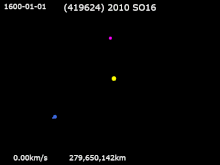 Many asteroids have been placed in groups and families based on their orbital characteristics. Apart from the broadest divisions, it is customary to name a group of asteroids after the first member of that group to be discovered. Groups are relatively loose dynamical associations, whereas families are tighter and result from the catastrophic break-up of a large parent asteroid sometime in the past. About 30–35% of the bodies in the asteroid belt belong to dynamical families, each thought to have a common origin in a past collision between asteroids. A family has also been associated with the plutoid dwarf planet Haumea. Some asteroids have unusual horseshoe orbits that are co-orbital with Earth or another planet. Examples are 3753 Cruithne and 2002 AA29. The first instance of this type of orbital arrangement was discovered between Saturn's moons Epimetheus and Janus. Sometimes these horseshoe objects temporarily become quasi-satellites for a few decades or a few hundred years, before returning to their earlier status. Both Earth and Venus are known to have quasi-satellites. Such objects, if associated with Earth or Venus or even hypothetically Mercury, are a special class of Aten asteroids. However, such objects could be associated with the outer planets as well. Spectral classificationIn 1975, an asteroid Chapman, Morrison, and Zellner.[117] These properties are thought to correspond to the composition of the asteroid's surface material. The original classification system had three categories: C-types for dark carbonaceous objects (75% of known asteroids), S-types for stony (silicaceous) objects (17% of known asteroids) and U for those that did not fit into either C or S. This classification has since been expanded to include many other asteroid types. The number of types continues to grow as more asteroids are studied.
The two most widely used taxonomies now used are the SMASS classification. The former was proposed in 1984 by David J. Tholen, and was based on data collected from an eight-color asteroid survey performed in the 1980s. This resulted in 14 asteroid categories.[118] In 2002, the Small Main-Belt Asteroid Spectroscopic Survey resulted in a modified version of the Tholen taxonomy with 24 different types. Both systems have three broad categories of C, S, and X asteroids, where X consists of mostly metallic asteroids, such as the M-type. There are also several smaller classes.[119]
The proportion of known asteroids falling into the various spectral types does not necessarily reflect the proportion of all asteroids that are of that type; some types are easier to detect than others, biasing the totals. ProblemsOriginally, spectral designations were based on inferences of an asteroid's composition.[120] However, the correspondence between spectral class and composition is not always very good, and a variety of classifications are in use. This has led to significant confusion. Although asteroids of different spectral classifications are likely to be composed of different materials, there are no assurances that asteroids within the same taxonomic class are composed of the same (or similar) materials. Active asteroids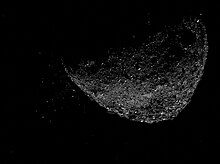 Active asteroids are objects that have asteroid-like orbits but show David Jewitt and Henry Hsieh, but this name implies they are necessarily icy in composition like a comet and that they only exist within the main-belt, whereas the growing population of active asteroids shows that this is not always the case.[121][123][124]
The first active asteroid discovered is 7968 Elst–Pizarro. It was discovered (as an asteroid) in 1979 but then was found to have a tail by Eric Elst and Guido Pizarro in 1996 and given the cometary designation 133P/Elst-Pizarro.[121][125] Another notable object is 311P/PanSTARRS: observations made by the Hubble Space Telescope revealed that it had six comet-like tails.[126] The tails are suspected to be streams of material ejected by the asteroid as a result of a rubble pile asteroid spinning fast enough to remove material from it.[127]  By smashing into the asteroid Dimorphos, NASA's Double Asteroid Redirection Test spacecraft made it an active asteroid. Scientists had proposed that some active asteroids are the result of impact events, but no one had ever observed the activation of an asteroid. The DART mission activated Dimorphos under precisely known and carefully observed impact conditions, enabling the detailed study of the formation of an active asteroid for the first time.[128][129] Observations show that Dimorphos lost approximately 1 million kilograms after the collision.[130] Impact produced a dust plume that temporarily brightened the Didymos system and developed a 10,000-kilometer (6,200 mi)-long dust tail that persisted for several months.[131][132][133] Observation and explorationUntil the age of space travel, objects in the asteroid belt could only be observed with large telescopes, their shapes and terrain remaining a mystery. The best modern ground-based telescopes and the Earth-orbiting Hubble Space Telescope can only resolve a small amount of detail on the surfaces of the largest asteroids. Limited information about the shapes and compositions of asteroids can be inferred from their light curves (variation in brightness during rotation) and their spectral properties. Sizes can be estimated by timing the lengths of star occultations (when an asteroid passes directly in front of a star). Radar imaging can yield good information about asteroid shapes and orbital and rotational parameters, especially for near-Earth asteroids. Spacecraft flybys can provide much more data than any ground or space-based observations; sample-return missions gives insights about regolith composition. Ground-based observations  As asteroids are rather small and faint objects, the data that can be obtained from ground-based observations (GBO) are limited. By means of ground-based optical telescopes the visual magnitude can be obtained; when converted into the absolute magnitude it gives a rough estimate of the asteroid's size. Light-curve measurements can also be made by GBO; when collected over a long period of time it allows an estimate of the rotational period, the pole orientation (sometimes), and a rough estimate of the asteroid's shape. Spectral data (both visible-light and near-infrared spectroscopy) gives information about the object's composition, used to classify the observed asteroids. Such observations are limited as they provide information about only the thin layer on the surface (up to several micrometers).[134] As planetologist Patrick Michel writes:
Near-Earth asteroids that come into close vicinity of the planet can be studied in more details with Goldstone Observatory in California (70 meter dish). Radar observations can also be used for accurate determination of the orbital and rotational dynamics of observed objects.[134]
Space-based observations 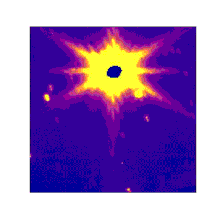 Both space and ground-based observatories conducted asteroid search programs; the space-based searches are expected to detect more objects because there is no atmosphere to interfere and because they can observe larger portions of the sky. NEOWISE observed more than 100,000 asteroids of the main belt, Spitzer Space Telescope observed more than 700 near-Earth asteroids. These observations determined rough sizes of the majority of observed objects, but provided limited detail about surface properties (such as regolith depth and composition, angle of repose, cohesion, and porosity).[134]
Asteroids were also studied by the Hubble Space Telescope, such as tracking the colliding asteroids in the main belt,[135][136] break-up of an asteroid,[137] observing an active asteroid with six comet-like tails,[138] and observing asteroids that were chosen as targets of dedicated missions.[139][140] Space probe missionsAccording to Patrick Michel
Dedicated missionsThe first asteroid to be photographed in close-up was Dactyl, all of which were imaged by the Galileo probe en route to Jupiter. Other asteroids briefly visited by spacecraft en route to other destinations include 9969 Braille (by Deep Space 1 in 1999), 5535 Annefrank (by Stardust in 2002), 2867 Šteins and 21 Lutetia (by the Rosetta probe in 2008), and 4179 Toutatis (China's lunar orbiter Chang'e 2 , which flew within 3.2 km (2 mi) in 2012).
The first dedicated asteroid probe was NASA's for three years. Hayabusa2, a probe launched by JAXA 2014, orbited its target asteroid 162173 Ryugu for more than a year and took samples that were delivered to Earth in 2020. The spacecraft is now on an extended mission and expected to arrive at a new target in 2031. NASA launched the OSIRIS-REx in 2016, a sample return mission to asteroid 101955 Bennu. In 2021, the probe departed the asteroid with a sample from its surface. Sample was delivered to Earth in September 2023. The spacecraft continues its extended mission, designated OSIRIS-APEX, to explore near-Earth asteroid Apophis in 2029. In 2021, NASA launched Double Asteroid Redirection Test (DART), a mission to test technology for defending Earth against potential hazardous objects. DART deliberately crashed into the minor-planet moon Dimorphos of the double asteroid Didymos in September 2022 to assess the potential of a spacecraft impact to deflect an asteroid from a collision course with Earth.[142] In October, NASA declared DART a success, confirming it had shortened Dimorphos' orbital period around Didymos by about 32 minutes.[143]
Planned missions
Asteroid mining The concept of asteroid mining was proposed in 1970s. Matt Anderson defines successful asteroid mining as "the development of a mining program that is both financially self-sustaining and profitable to its investors".[149] It has been suggested that asteroids might be used as a source of materials that may be rare or exhausted on Earth,[150] or materials for constructing space habitats. Materials that are heavy and expensive to launch from Earth may someday be mined from asteroids and used for space manufacturing and construction.[151][152] As From the SETI). Some astrophysicists have suggested that if advanced extraterrestrial civilizations employed asteroid mining long ago, the hallmarks of these activities might be detectable.[157][158][159]
Threats to Earth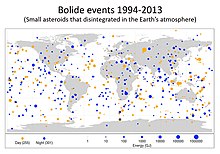 There is increasing interest in identifying asteroids whose orbits cross .The near-Earth asteroid 433 Eros had been discovered as long ago as 1898, and the 1930s brought a flurry of similar objects. In order of discovery, these were: 1221 Amor, 1862 Apollo, 2101 Adonis, and finally 69230 Hermes, which approached within 0.005 AU of Earth in 1937. Astronomers began to realize the possibilities of Earth impact. Two events in later decades increased the alarm: the increasing acceptance of the detect nuclear explosions , had detected hundreds of upper-atmosphere impacts by objects ranging from one to ten meters across.
All of these considerations helped spur the launch of highly efficient surveys, consisting of charge-coupled device (CCD) cameras and computers directly connected to telescopes. As of 2011[update], it was estimated that 89% to 96% of near-Earth asteroids one kilometer or larger in diameter had been discovered.[51] As of 29 October 2018[update], the LINEAR system alone had discovered 147,132 asteroids.[160] Among the surveys, 19,266 near-Earth asteroids have been discovered[161] including almost 900 more than 1 km (0.6 mi) in diameter.[162] In June 2018, the National Science and Technology Council warned that the United States is unprepared for an asteroid impact event, and has developed and released the "National Near-Earth Object Preparedness Strategy Action Plan" to better prepare.[163][164][165] According to expert testimony in the United States Congress in 2013, NASA would require at least five years of preparation before a mission to intercept an asteroid could be launched.[166] Asteroid deflection strategies Various collision avoidance techniques have different trade-offs with respect to metrics such as overall performance, cost, failure risks, operations, and technology readiness.[167] There are various methods for changing the course of an asteroid/comet.[168] These can be differentiated by various types of attributes such as the type of mitigation (deflection or fragmentation), energy source (kinetic, electromagnetic, gravitational, solar/thermal, or nuclear), and approach strategy (interception,[169][170] rendezvous, or remote station). Strategies fall into two basic sets: fragmentation and delay.[168][171] Fragmentation concentrates on rendering the impactor harmless by fragmenting it and scattering the fragments so that they miss the Earth or are small enough to burn up in the atmosphere. Delay exploits the fact that both the Earth and the impactor are in orbit. An impact occurs when both reach the same point in space at the same time, or more correctly when some point on Earth's surface intersects the impactor's orbit when the impactor arrives. Since the Earth is approximately 12,750 km in diameter and moves at approx. 30 km per second in its orbit, it travels a distance of one planetary diameter in about 425 seconds, or slightly over seven minutes. Delaying, or advancing the impactor's arrival by times of this magnitude can, depending on the exact geometry of the impact, cause it to miss the Earth.[172] " Apollo Command Module for guidance to the target. The warheads would be detonated 30 meters from the surface, deflecting or partially destroying the asteroid. Depending on the subsequent impacts on the course or the destruction of the asteroid, later missions would be modified or cancelled as needed. The "last-ditch" launch of the sixth rocket would be 18 hours prior to impact.[173]
FictionAsteroids and the asteroid belt are a staple of science fiction stories. Asteroids play several potential roles in science fiction: as places human beings might colonize, resources for extracting minerals, hazards encountered by spacecraft traveling between two other points, and as a threat to life on Earth or other inhabited planets, dwarf planets, and natural satellites by potential impact. See also
Notes
References
Further reading
External linksWikimedia Commons has media related to Asteroids. Look up asteroid in Wiktionary, the free dictionary.
|






